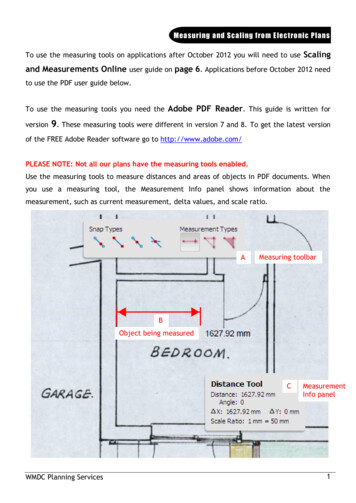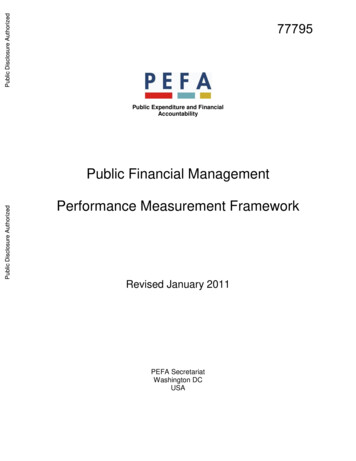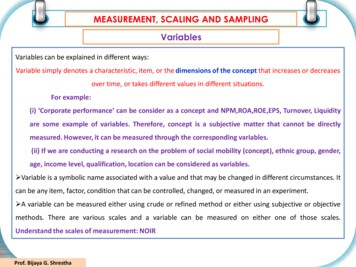
Transcription
LABORATORY SYSTEMIMPROVEMENT PROGRAMPerformance Measurement ToolDeveloped by the Association of Public Health LaboratoriesUpdated May 2022
The Association of Public Health Laboratories (APHL) works to strengthenlaboratory systems serving the public’s health in the US and globally. APHL’smember laboratories protect the public’s health by monitoring and detectinginfectious and foodborne diseases, environmental contaminants, terrorist agents,genetic disorders in newborns and other diverse health threats.This publication was supported by Cooperative Agreement # NU60OE000104-02 funded by the US Centers for DiseaseControl and Prevention (CDC). Its contents are solely the responsibility of the authors and do not necessarily represent theofficial views of CDC or the Department of Health and Human Services. 2022 Association of Public Health Laboratories. All rights reserved.
Performance Measurement ToolTABLE OF CONTENTSAbout the Tool.4-5Using the Tool.6-7Essential Service #1: Assess and Monitor Population Health Status, Factors that Influence Health, and CommunityNeeds and Assets. 8-12Essential Service #2: Investigate, Diagnose and Address Health Problems and Health Hazards Affecting thePopulation. 13-16Essential Service #3: Communicate Effectively to Inform and Educate People About Health Issues, Factors thatInfluence It, and How to Improve It. 17-20Essential Service #4: Strengthen, Support and Mobilize Communities and Partnerships to Improve Health. 21-27Essential Service #5: Create, Champion and Implement Policies, Plans and Laws That Impact Health.28-30Essential Service #6: Utilize Legal and Regulatory Actions Designed to Improve and Protect the Public’s Health. 31-34Essential Service #7: Assure an Effective System that Enables Equitable Access to the Individual Services andCare Needed to Be Healthy.35-38Essential Service #8: Build and Support a Diverse and Skilled Public Health Workforce.39-44Essential Service #9: Improve and Innovate Public Health Functions Through Ongoing Evaluation, Researchand Continuous Quality Improvement.45-50Essential Service #10: Build and Maintain a Strong Organization Infrastructure for Public Health. 51-553
4Laboratory System Improvement ProgramABOUT THE TOOLThe Laboratory System Improvement Program (L-SIP) Performance Measurement Tool is based onthe Eleven Core Functions and Capabilities of Public Health Laboratoriesi and is designed within theframework of the Ten Essential Public Health Services.ii (The former were developed through theAssociation of Public Health Laboratories (APHL) and have been used since 2002. The latter weredeveloped through a national collaborative process and have been in use since 1994.) The EssentialServices are the basis for the National Public Health Performance Standards Program tools, used forstate and local public health systems and for local Boards of Health.The initial version of the tool was developed by public health laboratory experts and partners,implemented in 2007, and used for 26 public health laboratory system assessments. As a part ofinternal continuous quality improvement, a workgroup of previous users who were experienced withthe assessment process utilized evaluations from previous assessments and their experience toupdate and refine the tool. The instrument is intended for measuring performance by assessing publichealth laboratory systems.The public health laboratory system (“System”) consists of all the participants in laboratory testing,including those who initiate testing, those performing the testing, and those who ultimately use thetest results. It is HIGHLY recommended that you refer to the User’s Guide before beginning use of thisinstrument for a more complete definition of the System, as understanding the concept of the Systemis of core importance to the assessment process.System performance relative to each of the Essential Services is measured through one or more KeyIdeas, each of which includes a Model Standard that describes aspects of high level performance forstate public health laboratory systems. The components of each Model Standard are termed “KeyIdeas.” Laboratory system performance related to each Model Standard is addressed through a seriesof Points for Discussion for each Key Idea.i Core Functions and Capabilities of State Public Health Laboratories: A Report of the Association of Public Health Laboratories (CDC 20sep02)ii Public Health Functions Steering Committee: Public Health in America. July 1994.
Performance Measurement ToolABOUT THE TOOL5(CONTINUED)APPROACH:The assessment of a System is best completed in one day using breakout groups. Consult the L-SIPUser’s Guide for ideas to assist in deciding which stakeholders to include and how to plan andstructure an assessment. A number of other important aids are found in this User’s Guide as well.USE OF FACILITATORS AND THEME TAKERS:It is strongly recommended that at least three facilitators be used to guide the process on the dayof the assessment. It is also recommended that the facilitators be “system neutral”—that is, notemployed by the state laboratory. This helps assure neutrality and minimize assessment bias. It isalso recommended that a “theme taker” be included for each Essential Service assessment. Thesuggested responsibilities of theme takers are described in the next section. More information isprovided in the L-SIP User’s Guide.BEGINNING THE ASSESSMENT:The facilitator will guide participants through a conversation about the Essential Services, ModelStandards, Objectives, Points for Discussion and Key Ideas. The purpose of the Points for Discussionis to guide a brief discussion among the participants regarding who is performing the activitiesreferenced and to what degree the questions are satisfied by the work currently being done bypartners within the System. Each of the Points for Discussion following the Key Idea is intended torepresent essential activities that the system should be performing in that area.Individuals in the group who have firsthand experience relative to one or more of the questions shouldshare their perspectives and experiences. When the group identifies an issue related to the Key Ideaor to one or more of the questions that requires deeper dialogue, the facilitator should ask the themetaker to capture that idea as a “parking lot” issue on the form provided for future consideration,and then move the group on to the next discussion. Many of the Key Ideas are accompanied by alist of “examples,” which are intended to add further clarity to the Key Idea and do not require a fulldiscussion.
6Laboratory System Improvement ProgramUSING THE TOOL“SCORING” THE RESPONSE:Once the questions for a Key Idea have been discussed, the facilitator should move the discussion toclosure. The facilitator should ask the group how they would rate performance by the System relativeto the Key Idea and the Points for Discussion. The performance options to be considered are:NONEMINIMALMODERATESIGNIFICANTOPTIMALIt is the facilitator’s responsibility to bring the group to general agreement on one of the ratingslisted above for each Key Idea (but not each individual question). One method used is to ask for a“straw vote” of individuals in the group, who vote by holding up a card with the color that matchesthat of the system performance rating (refer to the rating definitions below). If the resulting votereflects significant diversity of opinion, the facilitator may ask for a few members of the group whoshowed high and low rating cards to explain their vote. The discussion often helps lead to agreement.Additional “re-votes” can be used to determine if the group is coalescing around a rating.When general agreement is reached, the theme taker should record the rating on the instrumentscoring matrix located after the Points for Discussion and refer to the L-SIP User’s Guide or the scoringtool in the first tab labeled “Instructions.” The facilitator should guide the group through the scoringprocess, using the following definitions of the rating options:NONEMINIMALMODERATESIGNIFICANTOPTIMAL0% or absolutely none of the performance described is met within the public healthlaboratory system.Greater than zero, but no more than 25%, of the performance described is metwithin the public health laboratory system.Greater than 25%, but no more than 50%, of the performance described is metwithin the public health laboratory system.Greater than 50%, but no more than 75%, of the performance described is metwithin the public health laboratory system.Greater than 75% of the performance described is met within the public healthlaboratory system.
Performance Measurement ToolUSING THE TOOL7(CONTINUED)IMPORTANT NEXT STEPS:After the last Key Idea for each Essential Service is completed, the facilitator should lead a briefdiscussion of the top two to three “next steps” that System partners might consider taking tostrengthen system performance in the overall Essential Service. A ranking by priority regardingthe importance of each of the next steps is also suggested. The facilitator should help the groupdetermine a unified response.The responses will subsequently help identify priorities for system improvement projects. The themetaker should note the next steps selected by participants and, if possible, the name of contact personsresponsible for convening a first meeting to begin addressing the respective issues.SCORING SPREADSHEET:Provided with the L-SIP assessment kit is an Excel spreadsheet. Scores can be entered on thespreadsheet during the assessment, or sometime later. Refer to the User’s Guide or the scoring tool inthe first tab, labeled “Instructions.”FINAL NOTE:It is important that you retain worksheets that document the assessment, including scores, “NextSteps,” discussion notes, and parking lot records. These will be invaluable as you begin developing animprovement project with your partners and stakeholders to address areas of system performanceneeding improvement.
8Laboratory System Improvement ProgramESSENTIAL SERVICE #1ASSESS AND MONITOR POPULATION HEALTH STATUS, FACTORS THAT INFLUENCE HEALTH, AND COMMUNITYNEEDS AND ASSETSINTENT:Partners in the System are involved in the monitoring of health status of communities, identifying factors influencing health and contributingto communities’ health assessments to mitigate problems. The systems partners support surveillance programs to understand health in theirjurisdictions by generating high quality epidemiological and laboratory data in all areas in public health. Data are analyzed in a timely manner toidentify threats, trends and respond to emerging issues to reduce impact on all populations, including those that are disproportionately affected.EXAMPLES OF SYSTEM PARTNER CONTRIBUTIONS TO THIS ESSENTIAL SERVICEChronic disease monitoringNewborn screening monitoringInfectious disease investigating and reportingHealth information exchangeEnvironmental exposure monitoringLaboratory testingElectronic medical record implementationSpecimen/isolate submissionModel Standard 1.1: Monitoring of Community Health Status Through Surveillance Information SystemsThe System generates surveillance information and supports others in monitoring health status and identifying health problems in the community.MEASURABLE OBJECTIVES (SAMPLES): System partners conduct regular meetings to evaluate data regarding health events. Diverse partners participate in ongoing meetings and after-action reports for public health challenges. Partners’ roles and responsibilities in monitoring data are clearly defined. Continuity of Operations Plan (COOP) includes one or more Memoranda of Understanding (MOU) with other facilities for areas of critial and timesensitive testing. Data information systems used to compile and analyze data are integrated and interoperable. An assessment of data systems to track health issues and inform equitable actions is conducted on a routine basis, and appropriate follow-upmeasures are taken. Exercises are conducted among system partners to test the information exchange and its interoperability
Performance Measurement ToolKEY IDEA 1.1.1The System identifiesinfectious disease andenvironmental sentinelevents, monitors trends, andparticipates in state andfederal surveillance systems.EXAMPLES: Processes are in place for the publichealth laboratory (PHL) to obtainrepresentative isolates/specimensfor surveillance testing in a timelymanner. The academic, commercial,environmental, veterinary andagriculture laboratories collaboratein outbreaks with the systempartners. The System provides safe drinkingwater and biomonitoring testing.9Points for Discussion:Does the System: Contribute to and support a statewide sentinel surveillance system for infectious diseases andenvironmental events of public health significance? Engage its partners to determine the public health laboratory service needs of the community? Have multiple methods of gathering laboratory data from public and private laboratories? Contribute to the monitoring of foodborne outbreaks through collaboration among systempartners such as epidemiologists, clinical and public health laboratorians, and government agencyrepresentatives? Translate data into useful information to coordinate with state epidemiologists in determiningappropriate action, such as identifying disease clusters, calculating disease incidence, promotingfood safety and clean air, and examining for the presence of toxins?Evaluation:1.1.1How would you rate the performance ofthe System collectively on achieving thisKey Idea?Parking Lot Issues:NoneMinimal Moderate SignificantOptimal
10Laboratory System Improvement ProgramKEY IDEA 1.1.2The System monitorscongenital, inherited andmetabolic diseases ofnewborns and participates instate and federal surveillancesystems.EXAMPLES: Appropriate healthcare specialistsare made available for medical consultation for NBS. The System is represented on NBSprogram oversight.Points for Discussion:Does the System: Conduct newborn screening (NBS) or have an established resource (e.g., memoranda of understanding (MOU), formal contract, etc.) to ensure screenings and follow-up actions occur? Assure timely and safe transport of blood spots to the NBS PHL? Use nationally recommended NBS test panels, such as from the U.S. Department of Healthand Human Services Secretary’s Advisory Committee on Heritable Disorders in Newborns andChildren? Assure timely transfer of NBS data from point-of-collection to results sharing? Help to assure that infants with abnormal NBS findings are referred to appropriate medicalconsultants? Have an advisory committee, which includes a laboratory representative, that meets routinely todiscuss NBS best practices?Evaluation:1.1.2How would you rate the performance ofthe System collectively on achieving thisKey Idea?Parking Lot Issues:NoneMinimal Moderate SignificantOptimal
11Performance Measurement ToolKEY IDEA 1.1.3The System has a secure,accountable and integratedinformation managementsystem for data storage,analysis, retrieval, reportingand exchange. Partners collaborate to strengthen electronic surveillance systems.EXAMPLES: LIMS are capable of assimilatinginformation parallel with the flow ofspecimen processing and laboratoryreporting which covers pre-analyticaland post-analytical systems. The LIMS interfaces with appropriate health information systems. The PHL is fully staffed with knowledgeable informaticians in order toassure data quality and integrity.Points for Discussion:Does the System: Support highly integrated and comprehensive information systems (e.g., Laboratory InformationManagement System(LIMS)) that meet security and confidentiality requirements (e.g., server rooms,cyber security, access, administrative, etc.)? Have information technology (IT) systems with a database with capability to electronically sharelaboratory results and to utilize nationally recognized data standards (e.g., HL7, LOINC, SNOMED,ASC ANSI X12)? Support electronic laboratory reporting and real-time data exchange, including bidirectionalinformation exchange (e.g., test ordering, result reporting, disease reporting, health informationexchange, etc.), among relevant system partners? Budget for resources to update and manage hardware and software, e.g., fiscal, personnel,connectivity, etc.? Regularly evaluate needs and effectiveness for data systems via documented audits andvalidations? Partner with a variety of organizations to assure availability of a system that links the testing results(e.g. dairy, environmental, cannabis, etc.) to a reporting and surveillance system?Evaluation:1.1.3How would you rate the performance ofthe System collectively on achieving thisKey Idea?Parking Lot Issues:NoneMinimal Moderate SignificantOptimal
12Laboratory System Improvement ProgramESSENTIALSERVICE #1NEXT STEPSList top 2-3 possiblenext steps and rate as toimportance (immediate, high,medium, low) and a contactperson for each to addressat a first meeting.NEXT STEPSIMPORTANCESUGGESTED ACTIVITIES
Performance Measurement Tool13ESSENTIAL SERVICE #2INVESTIGATE, DIAGNOSE, AND ADDRESS HEALTH PROBLEMS AND HAZARDS AFFECTING THE POPULATIONINTENT:Partners in the System provide laboratory services of the highest quality, consistent with state and community needs. Members of the System collaborate through networks to support responses to public health challenges, and have the capacity, authority, resources, partnerships and infrastructure in place to assure an appropriate response.EXAMPLES OF SYSTEM PARTNER CONTRIBUTIONS TO THIS ESSENTIAL SERVICEClinical servicesInvestigational outcomesSurveillance activitiesParticipation in drills and exercisesCommunication pathwaysEmergency response networksSubmission of clinical isolatesModel Standard 2.1: Appropriate and effective high quality testing and dissemination of dataThe System assures the availability of appropriate laboratory testing of the highest level of quality to support timely diagnosis and investigation ofhealth problems and hazards, utillizing input from all communities and populations.MEASURABLE OBJECTIVES (SAMPLES): There is a mechanism to evaluate the quality of system services that meets related standards or regulations. Samples are monitored for quality assurance (i.e., specimen integrity, receipt times). Sufficient capacity exists in the system to assure laboratory response to emergencies in an equitable manner. Outbreak investigations are conducted through a partnership approach to assure needed expertise. Real-time dissemination of public health data is made available to all communities to inform responses to public health events.
14Laboratory System Improvement ProgramKEY IDEA 2.1.1The System assures theeffective provision of servicesat the highest level of qualityto assist in the detection,diagnosis and investigationof all significant healthproblems and hazards.EXAMPLES: The System complies with local, stateand federal regulations governing thedevelopment, validation and use oftests and services. Knowledge of users on test limitations is assured (e.g., sensitivity,specificity). Compliance and regulatory inspectionresults are available and current (e.g.proof of certificates of compliance oraccreditation). Laboratories and providers meetdisease-reporting requirementsof reportable diseases and healthhazards.Points for Discussion:Does the System: Possess scientific expertise and necessary resources to assure the highest level of appropriatequality testing? Use its combined resources, including staff, equipment, technology, methodology, and supplies torespond to health problems and hazards? Assure the necessary system capacity with the appropriate level of containment (e.g., biosafetyLevel 3 capacity, lead containers for radioactivity, etc.)? Have timely communication with customers and stakeholders to support diagnosis andinvestigations? Support public health investigations through participation of system partners, includingepidemiologists, first responders, health care providers, environmental professionals, etc.?Evaluation:2.1.1How would you rate the performanceof the System collectively on achievingthis Key Idea?Parking Lot Issues:NoneMinimal ModerateSignificantOptimal
Performance Measurement ToolKEY IDEA 2.1.2The System has thenecessary capacity andauthority in place to rapidlyrespond to public healthevents.EXAMPLES: Implementation of the IncidentCommand System (ICS) and HealthAlert Network messaging is standardpractice. All response plans, such asCOOP, surge capacity, emergencycommunication, etc., are inalignment. To facilitate a rapid responsein emergencies, the necessaryagreements, contracts andinterstate compacts to expeditepurchases, service contracts,shared personnel, facilities andsupplies, including stockpiledreagents are in place.15Points for Discussion:Does the System: Have the ability to provide for triaging and testing of samples that may contain potential biological, radiological, or chemical threats, including a process that provides for laboratory specimentracking, results reporting, interpretation and use of laboratory information? Utilize public health preparedness and response networks, (e.g. biological, chemical, radiological,food, etc.)? Include a representative cross-section of members in the development and definition of partnerroles, Continuity of Operations Plan (COOP), preparedness and response?Evaluation:2.1.2How would you rate the performance ofthe System collectively on achieving thisKey Idea?Parking Lot Issues:NoneMinimal Moderate SignificantOptimal
16Laboratory System Improvement ProgramESSENTIALSERVICE #2NEXT STEPSList top 2-3 possiblenext steps and rate as toimportance (immediate, high,medium, low) and a contactperson for each to addressat a first meeting.NEXT STEPSIMPORTANCESUGGESTED ACTIVITIES
Performance Measurement Tool17ESSENTIAL SERVICE #3COMMUNICATE EFFECTIVELY TO INFORM AND EDUCATE PEOPLE ABOUT HEALTH, FACTORS THAT INFLUENCE IT, ANDHOW TO IMPROVE ITINTENT:Partners of the System are actively engaged in developing and disseminating culturally and linguistically appropriate, accurate and relevantinformation about laboratory issues to health partners (e.g., providers, physicians) and non-health partners (e.g., public, policy makers). Systempartners participate in outreach through education and communication to identify needs, share appropriate information and ensure partnershipsexist to empower communities to initiate programs in response to health problems.EXAMPLES OF SYSTEM PARTNER CONTRIBUTIONS TO THIS ESSENTIAL SERVICEClinical servicesIdentification of laboratory issuesRequests for laboratory input & expertiseParticipation in development of informationEducational opportunitiesModel Standard 3.1: Outreach to PartnersThe System provides targeted laboratory information and educational opportunities to appropriate health and community partners and empowersthem to collaborate on prevention and health promotion strategies.MEASURABLE OBJECTIVES (SAMPLES): A defined process, which is monitored for timeliness and consistency, is established with partners to communicate information to a variety ofstakeholders. A mechanism is in place that tracks and supports feedback among partners to ensure effective and useful educational activities. Partnership networks are identified, promoted and utilized across the System. Tracking of relationship-building and community partner educational activities is maintained
18Laboratory System Improvement ProgramKEY IDEA 3.1.1The System develops anddisseminates accurate andconsistent information tocommunity partners aboutrelevant health issuesassociated with laboratoryservices.EXAMPLES: Partners are provided withappropriate communication toolsand resources (e.g., social media,peer-to-peer networks, mass media,and other channels) to understandand utilize the public healthlaboratory services. Two-way Information-sharingoccurs consistently for routine andemergency situations. An authorization process is in placefor the release of information whererequired.Points for Discussion:Does the System: Support processes that distribute accurate and consistent public health laboratory information tocommunity partners? Conduct outreach to partners to provide resources and information about laboratory services? Assure that the communication and information between health partners and the communitystakeholders is culturally and linguistically appropriate? Conduct outreach to the general public about laboratory services?Evaluation:3.1.1How would you rate the performanceof the System collectively on achievingthis Key Idea?Parking Lot Issues:NoneMinimal ModerateSignificantOptimal
Performance Measurement ToolKEY IDEA 3.1.2The System creates andprovides educationalopportunities to communitypartners.EXAMPLES: There is a mechanism for identifyingand developing educationalpresentations for communitypartners. Messages to community partnerscontain relevant, timely andaccurate information. Publications with updated andtargeted laboratory information areavailable to stakeholders.19Points for Discussion:Does the System: Participate in the education of public health officials, partners, state and local legislators and theacademic community on current and emerging laboratory issues? Offer a variety of community educational opportunities that are broad-based and include multicultural, rural and urban perspectives? Use multiple communication approaches (e.g., websites, flyers, social media/marketing, etc.) andlevels of complexity (e.g., reading levels, technical level, multiple languages) for educating partners and the public? Work proactively with the media to educate stakeholders about laboratory topics and matters?Evaluation:3.1.2How would you rate the performanceof the System collectively on achievingthis Key Idea?Parking Lot Issues:NoneMinimal ModerateSignificantOptimal
20Laboratory System Improvement ProgramESSENTIALSERVICE #3NEXT STEPSList top 2-3 possiblenext steps and rate as toimportance (immediate, high,medium, low) and a contactperson for each to addressat a first meeting.NEXT STEPSIMPORTANCESUGGESTED ACTIVITIES
Performance Measurement Tool21ESSENTIAL SERVICE #4STRENGTHEN, SUPPORT, AND MOBILIZE COMMUNITIES AND PARTNERSHIPS TO IMPROVE HEALTHINTENT:The SPH Laboratory leads the development of the SPH Laboratory System. Members of the System create and maintain a network of partnershipswith a diverse group of stakeholders representing different communities in order to identify and solve health problems related to the laboratorysystem. System members communicate regularly with each other to foster collaboration and share resources to support the mobilization of partnerships in response to community health issues.EXAMPLES OF SYSTEM PARTNER CONTRIBUTIONS TO THIS ESSENTIAL SERVICEClinical servicesLeadershipCollaborationEnvironmental awarenessMulticultural AwarenessModel Standard 4.1: Partnership DevelopmentPartners within the System demonstrate collaborative relationships with each other.MEASURABLE OBJECTIVES (SAMPLES): The System roles and responsibilities are defined for members of the System. The System has an ongoing monitoring process to measure and evaluate the effectiveness of partner collaboration. The System has a process in place to address feedback from partners.
22Laboratory System Improvement ProgramKEY IDEA 4.1.1Partners in the Systemdevelop and maintain relationships to formalize andsustain an effective system.EXAMPLES: Agreements (formal and/orinformal) are in place to delineatepartner responsibilities. Partnerships are sustainedfinancially, politically and/orprogrammatically. An individual from the system isa dedicated liaison with clinical/hospital-based laboratories (i.e.,Laboratory Program Advisor (LPA)). Depending on state rules of conduct, the system may create asteering committee, advisory orsimilar group that meets regularly toprovide feedback and guidance tothe system.Points for Discussion:Does the System: Regularly convene partners to strengthen the System? Formally define the roles and responsibilities of member organizations within the SPH LaboratorySystem? Have a process for identifying key constituents and building partnerships among memberorganizations? Address the need for member organizational missions, visions, and values to be in alignment withthe goals of the System?Evaluation:4.1.1How would you rate the performanceof the System collectively on achievingthis Key Idea?Parking Lot Issues:NoneMinimal ModerateSignificantOptimal
Performance Measurement ToolModel Standard 4.2: CommunicationThe System is structured to support regular and effective communication.MEASURABLE OBJECTIVES (SAMPLES): Member
4 Laboratory System Improvement Program The Laboratory System Improvement Program (L-SIP) Performance Measurement Tool is based on the Eleven Core Functions and Capabilities of Public Health Laboratoriesi and is designed within the framework of the Ten Essential Public Health Services.ii (The former were developed through the Association of Public Health Laboratories (APHL) and have been used .










